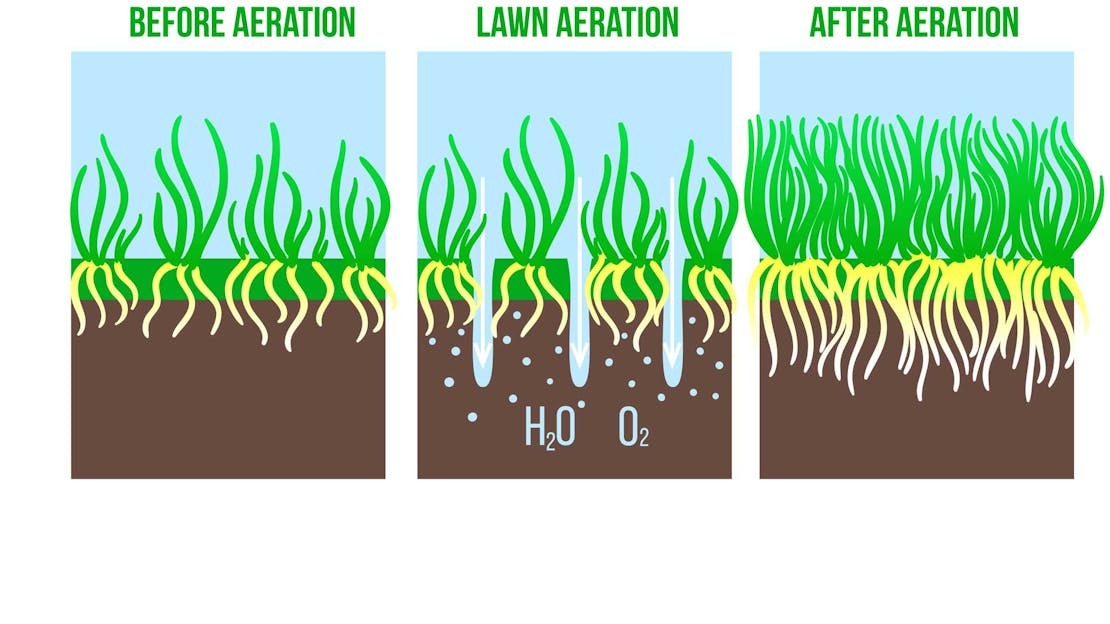
Improving Drought Tolerance in Lawns
With the right preparation, you can affect how long your lawn stays green during dry conditions. See how to retain the green in your grass in summer for longer.
With the right preparation you can affect how long your lawn stays green during dry conditions by several weeks. The following impact how quickly you lawn will stay green without rain:
- Lawn age - the older the lawn the sooner it will dry
- Compaction - a combination of age and use increases drying
- Soil Type - sandy soils dry soonest
- Poor nutrition - grass less able to control moisture loss
- Grass type - deeper rooting grasses stay green a little longer
- Mowing regime - short grass or mowing infrequently increases drying
The following aspects of lawn care, done correctly can greatly improve and retain the green in your grass during dry weather.
Lawn Fertiliser
In spring and summer ensure your feed has potassium in it – the K in NPK. This helps the grass plant control moisture loss.
Shade
Some shade will reduce evaporation and transpiration and keep the lawn cooler. This can have a reverse effect if the shade is from a tree whose roots run close to or in the lawn.
Lawn Aeration and Compaction
A well aerated or relatively new lawn will have a lot of air spaces between the grains of soil. These spaces hold water so the more spaces you have the more water your soil can hold. The opposite of this is compaction where spaces between soil grains are non-existent which means the water holding capacity is minimal. These lawns are the first to turn brown when conditions become dry. This occurs in heavily used lawn areas and older lawns.
Use core aeration in late autumn only, at other times spike the lawn, you can’t over do it!
Mowing the Lawn
Think of the grass plant a bit like an iceberg, one tenth above ground and nine tenths below. This means that grass cut at say 6cms will have twice the root depth of grass cut at 3cms. A higher setting on the mower will enable the roots to grow deeper. It can take a few months for the roots to make this extra growth, but any extra grass length will be beneficial.
Leaving fine clippings on the lawn by mowing with the box off if the mower instructions allow is also beneficial in conserving a little moisture.
CAUTION: Do continue to mow regularly. Removing more than one third of the grass blade or mowing infrequently will cause stunted root development.
Wetting Agents
These have two main benefits:
- assist water to penetrate dry soil rather than running off
- increase water retention between soil particles in any soil
If used correctly a wetting agent can increase the amount of water available to the lawn by up to 50%. Wetting agents are invaluable at times, enabling better and more economical use of water. They are not a substitute for water and will have limited benefit on compacted soils.
To find out more visit When to use Wetting Agents
Grass Type
Some grasses have deeper roots than others. Lawnsmith Staygreen has 2 out of 3 grass species that develop very deep roots indeed. Combining this with frequent mowing at 5cms plus will make a major improvement in the lawn’s drought tolerance. Fortunately, this grass mixture is also happy in full sun and is also hard wearing. It is not the finest of grasses but infinitely better than a brown ornamental lawn!
If you’re starting a new lawn then this is perfect for sandy soils or the dry east of the country. If over seeding, you need to consider the following:
- It can take several over seeding sessions to make a marked change in the lawns drought tolerance
- If the soil is compacted or the lawn is old then you should address this before relying on Staygreen to remedy the problem